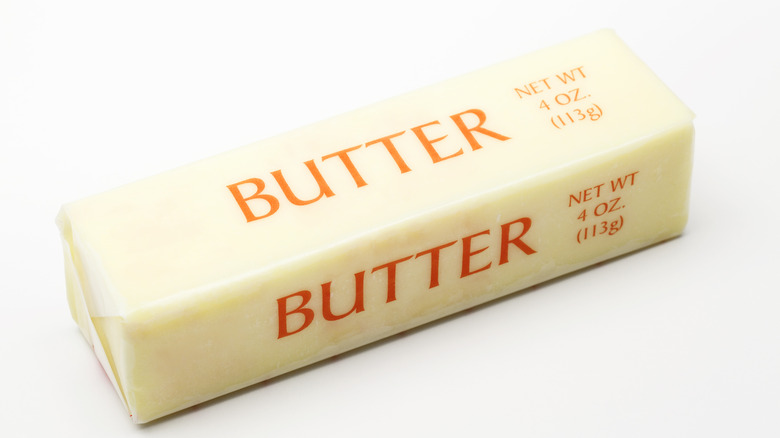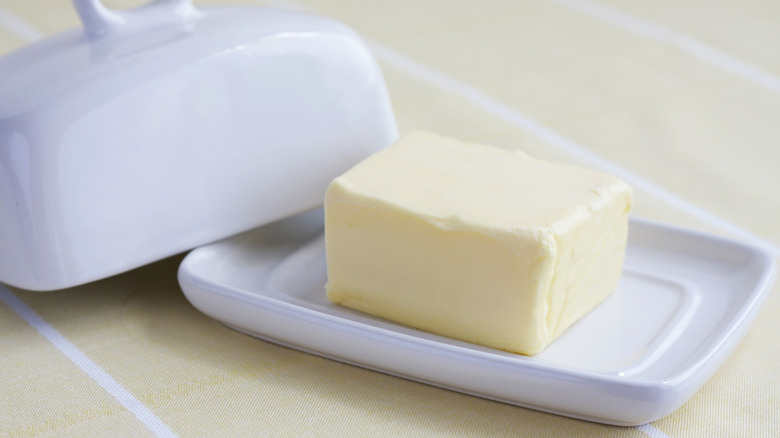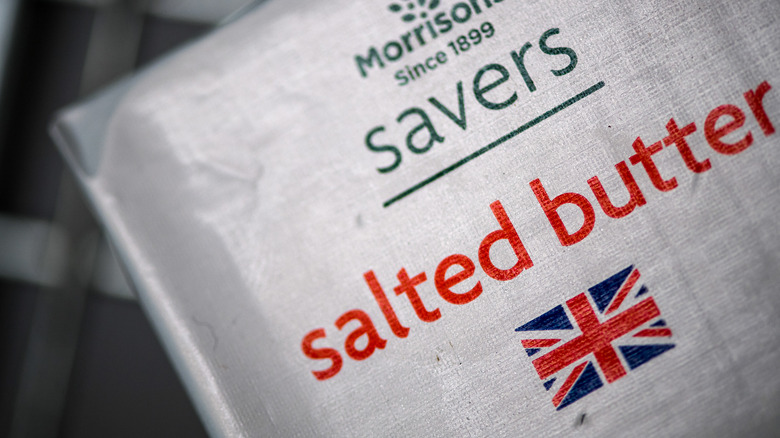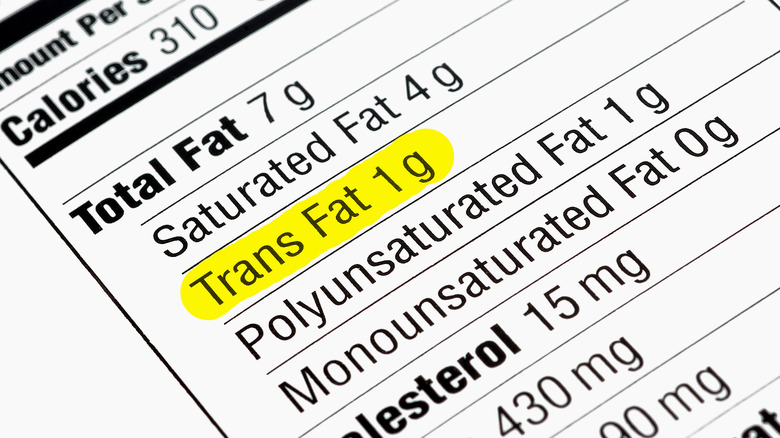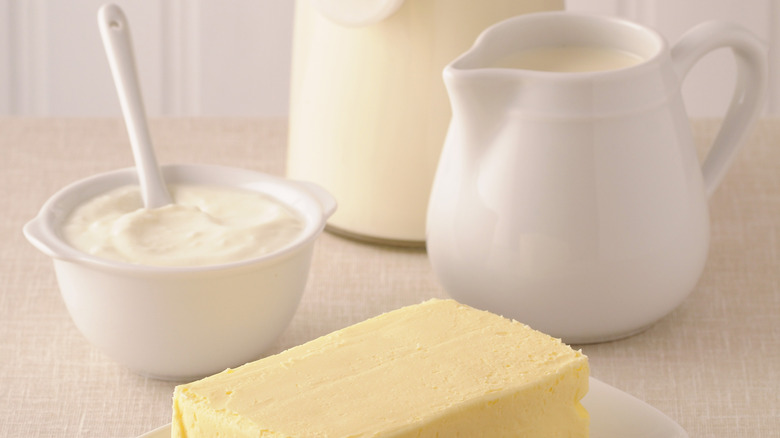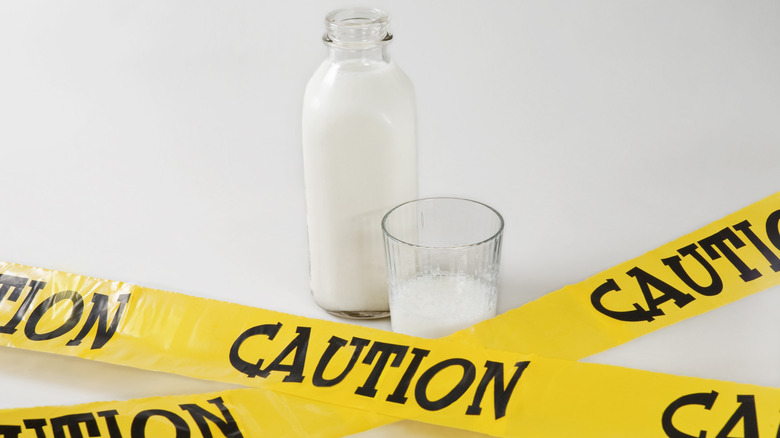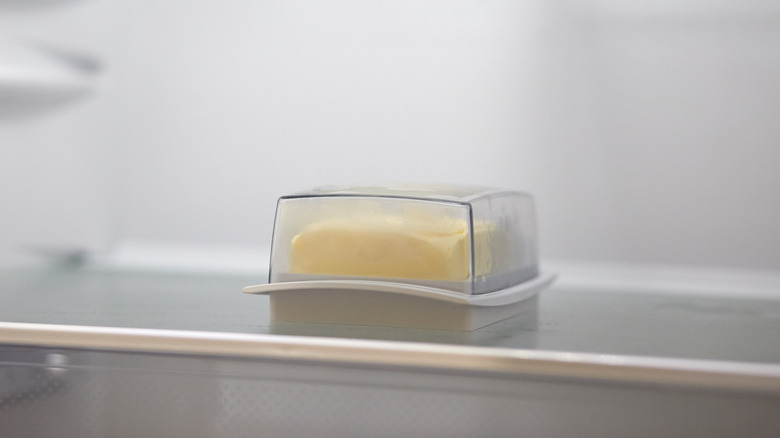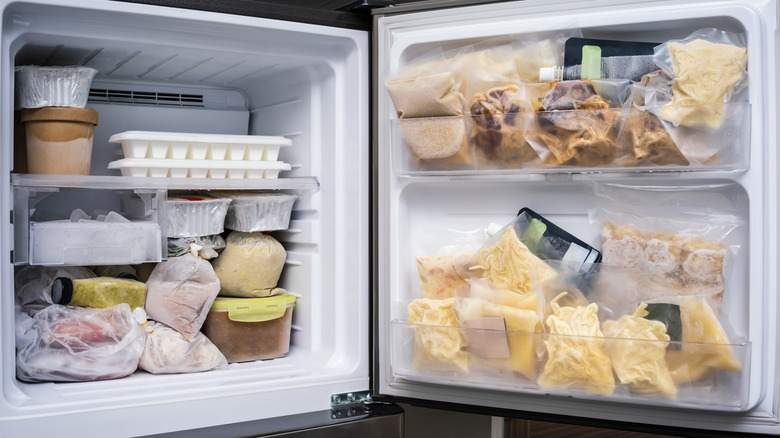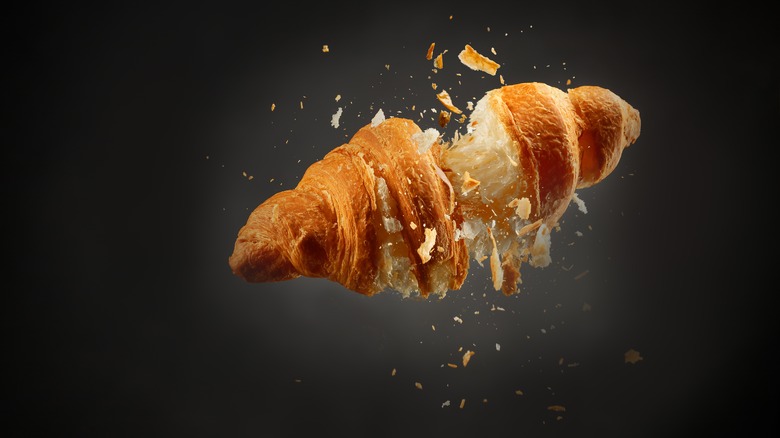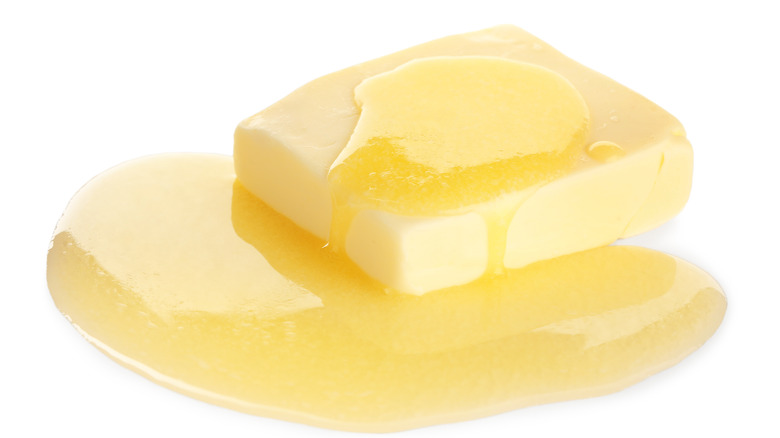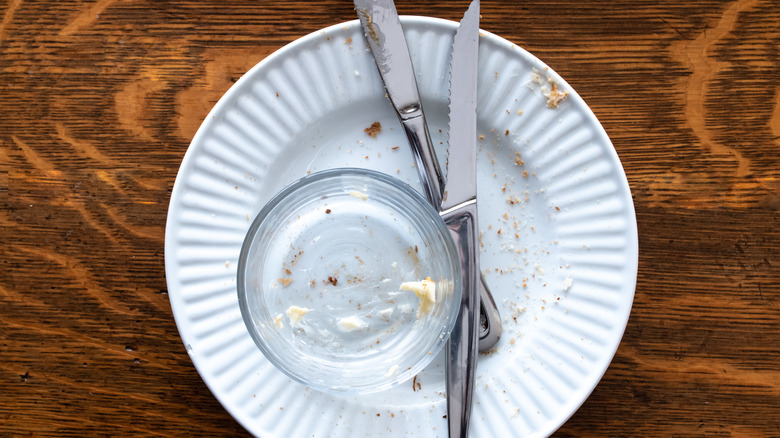False Facts About Butter You Thought Were True
Butter may be one of the most common foods you'll ever use, but it's also one of the most misunderstood. Myths swirl around butter, from its effect on your health to where you can store it to how it's used at the state fair. Learning about these false facts will help you be a better baker and have a better grasp of food safety — not to mention you'll have a better idea of what's going on with your household plumbing system.
As with many false food facts, what's false in one region may be true in another, and what's worked for one person may not work for a second. The point here is to give you information that you can apply to your butter that's appropriate for your life and where you live. And yes, where you live actually does play a role in how you handle butter. So here are some false facts about butter you thought were true and a look at what you should really know.
False: You have to keep it refrigerated
Let's get this one over with: No, you don't have to keep butter refrigerated all the time in many regions (those of you in hotter regions, we'll get to you in the next section). You can't keep it out indefinitely, but you can keep some salted butter out for one to two days in a covered, opaque container in a kitchen that's cooler than 70 degrees Fahrenheit. Do not do this with margarine, by the way; the oil content makes it separate and break down when it's left out. One popular container is called a butter bell, which uses water to create a seal; however, an opaque butter dish should work just fine.
Why only salted butter? The salt content helps preserve the butter. Unsalted butter doesn't have that advantage. You can keep unsalted butter out for a while, such as when trying to soften it, but any butter actually stored on your counter should be salted.
False in many areas: You can leave it out on the counter
Right now, anyone who's ever lived in Phoenix in summer is laughing at the idea of leaving butter on the counter. In many regions, you can leave butter on the counter for a short time. But if you live in an area where your home gets fairly hot and is difficult to cool, then keep butter in the refrigerator. This includes areas where the outside temperatures are so hot that air conditioning can't cool home interiors that well; if it's 115 degrees outside, your home likely isn't going to be in the low 70s.
Also of concern are cooler regions where homes don't have air conditioning but do trap heat during summer afternoons. That means that if you leave butter out, thinking that your home will be cool throughout the day, you could inadvertently be helping the butter turn rancid because of the heat exposure in the afternoons. If you can't keep the temperature in your kitchen below 70 degrees — and many kitchens never get this cool during the day — don't leave butter out on the counter.
Sometimes false: The salt level doesn't make a difference
Unsalted and salted butter are exactly what they sound like; one contains more salt than the other. There are these dual myths that say that either the salt level doesn't matter, or that it always matters. They're both sometimes false. For example, if you're having buttered toast, you might want to use salted butter for a richer taste. But if you're adding cinnamon sugar on top of the butter, you might not be able to detect any salty flavor, so the salt level wouldn't matter. Using unsalted butter is supposed to let you control the amount of salt in a recipe, but so many recipes have other flavors that the salt in the butter might not be detectable in many cases. Note that there are exceptions, especially when using a large amount of butter; use unsalted butter in homemade frosting, for example.
Something many bakers might not realize is that the salt level affects the moisture content, which has a greater effect on baked goods than the salt level does. Salted butter tends to have more moisture, and that can throw off the texture of the finished baked good — the key word there being "can." It doesn't always, and if your baked good relies on gluten formation, you might see more of an effect and need to use unsalted butter for better results. But for your typical fast-baked cookies and snack cakes, you might not see much of a difference.
Refreshingly false: It's a really unhealthy food because of its fat content
Butter used to be vilified. It was supposed to be a contributor to heart disease and all sorts of physical ills because of all the saturated fat it contained, and worst of all, eating it would make you gain weight, or so everyone was told. People were supposed to eat margarine and butter-flavored spreads instead. Then, in 2014, a study came out that showed that reducing saturated fat didn't help reduce heart disease risk, and it turned out that butter wasn't the worst thing on the planet. (Meanwhile, it turned out that margarine and those spreads were actually worse than originally thought.) And while fat is more caloric than protein and carbohydrates, dietitians and doctors agreed that just eating fatty foods such as butter didn't mean you were going to be fat.
The idea that butter is bad is a false fact that's taking its time to go away. However, having a little good-quality butter on your corn on the cob or on toast isn't going to harm you or most people (obviously, if you have a medical condition such as a dairy allergy, you don't want to eat it). In fact, that butter ensures you get some satisfying fat in your diet that helps your body function properly. Look for butter that's organic or that's from grass-fed cows if you can.
Sensibly false: It's a totally healthy food because it's a whole food
Butter may not be the worst food to eat anymore, but you still need to watch how much of it you do eat. Butter is now seen as a "real" food with simple ingredients, something that people ate back before ultra-processed foods were a thing. Yes, it's a tasty food with a long history, but that doesn't mean it's something you should eat a lot of. While saturated fat is no longer seen as the cause of all ills, you do want to treat it and butter as foods to have in moderation.
That 2014 study — which showed that saturated fat wasn't as bad as we thought — was criticized for not looking at what people were eating in place of saturated fat because what they ate instead could have influenced the results. As one critic pointed out, someone replacing saturated fat with sugar may show no change in heart disease risk, but someone replacing saturated fat with fish and olive oil could show improvement in heart disease risk. So while having some butter should be fine as part of a balanced diet, you do want to continue to eat these foods with moderation in mind and ensure that the rest of your diet is as healthy as possible.
Very false: Butter is made with low-quality milk
Where did this false fact come from? Did someone have tasteless butter once and decide that this was how all butter was made? Butter isn't made with low-quality milk or low-quality cream. It could be, but stuff like that wouldn't sell. The quality of the butter you have varies based on the quality of the cream used, so to get high-quality butter that people will want to buy, companies have to use high-quality cream. If you try a brand of butter and think it's terrible, switch to another brand.
Now, it is true that the process of making quality commercial butter isn't as easy as it looks. The amount of oxygen and light exposure, the storage temperature, the pH of the cream, and other factors can contribute to bad odors and horrible tastes. Companies have to get that mixture just right in order to produce butter that tastes and smells normal. But any company that really wants to sell butter has to start with good-quality cream.
We wish this weren't false: The temperature of the butter doesn't matter
Even the most avid baker occasionally cuts some corners in recipes. Sometimes you just don't want to deal with all the details because you don't have time to wait for this ingredient to warm up or for that ingredient to chill properly. That's acceptable to an extent, but it turns out that it's not that great when the details involve butter. Or, more specifically, the temperature of the butter. When you see a recipe mention cold, softened, room-temperature, or some other temperature of butter, do your best to follow that instruction. The recipe mentions the temperature of the butter for a reason, and no, it's not to annoy you.
The temperature of the butter affects how well it holds air, which affects how dense the final food will be. It allows for smoother or rougher mixing; for example, room-temperature butter allows you to mix ingredients more thoroughly and produce a smoother batter, while cold butter in a dough won't melt as quickly when the dough is baked. That's crucial for cookies that are supposed to be thick, rather than thin and spread out. If you use butter that's the wrong temperature for a recipe, the result may still be edible and may still taste good, but it will look different and likely have a different texture or mouthfeel.
False if you have a freezer: You have to use up butter quickly
Pick up a package of butter in the grocery store, and you'll see a best-by date that's often not that far away. Given that many packages of butter hold about a pound of the stuff, it may seem like you don't have much time to use up the entire amount. Butter kept in the refrigerator should last about six to nine months, but you can extend that life span easily by tossing most of the butter into the freezer. That should give you another six (unsalted) to 12 (salted) months before quality starts to decline.
One word of caution: As long as the butter is kept at 0 degrees Fahrenheit, it shouldn't go bad from a food-safety standpoint no matter how long you leave it in the freezer. The quality can degrade, however, and even butter can become unappealing when thawed after a long time in the freezer. If you place butter in the freezer, mark the packaging with the date and plan to use it within a year or so, if not sooner.
False: You have to use European butter in baking
European butter has more butterfat than American butter (around 82% to 86% for European and about 80% for American), and less water. This is a great butter to use for laminated dough. It's also nice to spread on bread for a snack because of how well it softens. However, using European butter in a non-European recipe can be disastrous because the higher butterfat and lower moisture content can make your baked good overly greasy and crumbly in a bad way. The King Arthur Baking Company tested a shortbread recipe by making one batch with American grade AA butter and another with European butter, and then leaving the rounds on craft paper for two hours. The European butter version leaked a lot more grease than the AA version and changed the texture.
The only time it really matters whether you use European butter is if the recipe you're making is from Europe — as in, written and tested using European butter. The ingredient amounts are calculated assuming the butter you're using has that higher fat content. If you're baking something from a U.S.-created and tested cookbook or food blog, you'll want to use U.S. butter. One Redditor found conversion advice from expert baker Stella Parks: Per 1 cup of butter, "try decreasing the butter by a tablespoon/16 g[rams], and then add 1 tablespoon/16 g[rams] water to the butter/sugar during the creaming phase. Should make up for the difference."
Mostly false: You can use melted butter in place of softened or cut butter
Many baking recipes require you to cut in chunks of butter, and if you're not that enthusiastic about baking, for whatever reason, the step can be annoying at best. The dough becomes crumbly and sticky, your hands get greasy, and your arms get tired. A shortcut endorsed by some is to melt the butter and mix that in quickly. That can work in limited cases where you're just trying to bind something together like a crumb topping. But melted butter creates a different texture than softened butter. If you have a recipe that calls for softened butter to be mixed into the main bulk of a recipe (such as a batter, rather than a topping), stick with softened butter to get the right texture.
If you're having trouble getting butter to soften up enough to cut it in, don't resort to melting it. If it's soft enough to cut, try that first; the more surface area that's exposed to warm temperatures, the faster the butter will soften. You can try grating butter, but watch your hands and don't let the butter slip. Microwaving can be tricky because that's normally a way to melt butter instead of softening it, but a few seconds at a very low power, like the 30% defrost setting, may help.
Sadly false: Butter sculptures are carved out of solid butter
Butter sculptures are common sights at state fairs and other exhibitions, and the sight of butter carved into intricate designs has captivated many onlookers. It turns out, though, that most of those sculptures aren't made of only butter. As disappointing as that might be, it makes sense, and sculptors are pretty open about it. The CBC interviewed one sculptor who said that butter doesn't really have a stable form, unlike ice. The butter can fall, and as sculptures get bigger, support is necessary. As a result, sculptors make underlying structures out of foam and other materials and then cover those in butter. The minute details are still hand-carved, and smaller sculptures can be made of all butter. But the large spectacles you see on display at fairs? Those usually have a core made of something solid.
By the way, if you're worried about food products being wasted in these competitions, don't be. The butter used is usually inedible for a number of reasons, and it's often recycled again after the event. At the New York State Fair, for example, members of the Cornell Cooperative Extension Master Gardeners' group remove the butter and bring it to a local farm, where the butter is placed in a digester, converted to electricity, and fed back in the local electrical grid.
Urgently false: Just wash butter down the drain with hot water
Butter melts in hot water and solidifies in cold water. When you wash butter down the drain with hot water, it melts and disappears. But once it's traveled down the drain a bit into cooler territories where the water has lost some heat, it re-solidifies and sticks to the walls of the pipe. Over time, it builds up into a pipe-clogging mass that's very difficult to break up.
It's understandable why people think it's okay to wash the stuff down with hot water. If you let butter go down the drain, the advice usually is to turn on the hot water and let it run, often adding some grease-fighting dish soap. That's not because hot water will take care of it; it's because at that point, it's impossible to clean all the butter out of the drain, so running the hot water is better than nothing.
Before you wash dishes, wipe off as much butter and grease as you can with a paper towel and place it in the trash. If you have hot melted butter that you need to clean up, let it cool, scrape most of it into the trash, and then scrub the rest off with baking soda, which you should then put in the trash. If you have a stick of butter to dispose of, throw it away. Do not compost butter, as it can attract pests and start to smell awful as it breaks down.
